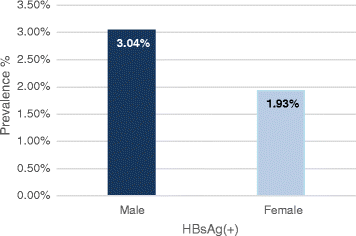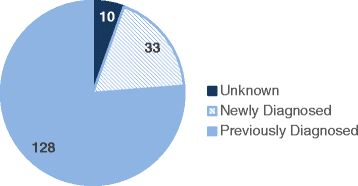Chronic hepatitis B in Korean Americans: decreased prevalence and poor linkage to care
- PMID: 27526685
- PMCID: PMC4986342
- DOI: 10.1186/s12879-016-1732-7
Chronic hepatitis B in Korean Americans: decreased prevalence and poor linkage to care
Abstract
Background: Chronic hepatitis B virus(HBV) infection is a major cause of liver related morbidity and mortality. HBV infection remains largely underdiagnosed in Asian American population, and it is also poorly linked to clinical care. We, therefore, assessed the HBV prevalence and evaluated linkage to care among Korean Americans in order to develop strategic plans to reduce the impact of HBV in a high risk community.
Methods: Serologic screening and survey were provided to 7157 Korean American adults (age 21-100) in New Jersey between December 2009 and June 2015. All participants were tested for hepatitis B surface antigen (HBsAg), hepatitis B surface antibody (anti-HBs), and hepatitis B core IgG antibody (anti-HBc). Additional survey was conducted on the subjects chronically infected with HBV on their history of infection. Self-administered questionnaires were employed to evaluate demographic and epidemiologic characteristics.
Results: Of those 7157screened, 171 (2.4 %) were HBV infected, 2736(38.2 %) were susceptible to HBV, and 4250(59.4 %) were immune. The prevalence of chronic HBV varied between the age groups: 1.18 % (age21-30); 2.53 % (age 31-40); 2.76 % (age 41-50); 2.90 % (age 51-60); 2.06 % (age 61-70); and 1.37 % (age 71-100). The rate of HBsAg was significantly higher in males (3.04 %) as compared to females (1.93 %). At least 75 % of these HBV infected subjects had been previously diagnosed, but were not engaged in care.
Conclusion: This screening study suggests that the HBV prevalence in Korean Americans is significantly lower than currently understood. On the other hand, many of the individuals chronically infected with HBV cannot access care, suggesting a poor linkage-to-care (LTC). Further, a large percentage of the population is still susceptible to HBV. Study findings will be used to develop strategies to tailor community-based HBV screenings and LTC to the high risk populations.
Keywords: Hepatitis B screening; Korean Americans; Linkage to care.
Figures





Similar articles
-
The prevalence and significance of isolated hepatitis B core antibody (anti-HBc) in endemic population.BMC Res Notes. 2019 May 6;12(1):251. doi: 10.1186/s13104-019-4287-z. BMC Res Notes. 2019. PMID: 31060623 Free PMC article.
-
Long term outcome of a community-based hepatitis B awareness campaign: eight-year follow-up on linkage to care (LTC) in HBV infected individuals.BMC Infect Dis. 2019 Jul 18;19(1):638. doi: 10.1186/s12879-019-4283-x. BMC Infect Dis. 2019. PMID: 31319805 Free PMC article.
-
The prevalence of hepatitis B virus infection markers and socio-demographic risk factors in HIV-infected patients in Southern Brazil.Rev Soc Bras Med Trop. 2014 Sep-Oct;47(5):552-8. doi: 10.1590/0037-8682-0109-2014. Rev Soc Bras Med Trop. 2014. PMID: 25467254
-
New strategies for blood donor screening for hepatitis B virus: nucleic acid testing versus immunoassay methods.Mol Diagn Ther. 2006;10(2):77-91. doi: 10.1007/BF03256447. Mol Diagn Ther. 2006. PMID: 16669606 Review.
-
Occult hepatitis B virus infection.Transfus Clin Biol. 2004 Feb;11(1):18-25. doi: 10.1016/j.tracli.2003.11.007. Transfus Clin Biol. 2004. PMID: 14980545 Review.
Cited by
-
Hepatitis B virus screening in Asian immigrants: Community-based campaign to increase screening and linkage to care: A cross-sectional study.Health Sci Rep. 2023 Mar 3;6(3):e773. doi: 10.1002/hsr2.773. eCollection 2023 Mar. Health Sci Rep. 2023. PMID: 36875931 Free PMC article.
-
Racial/ethnic- and county-specific prevalence of chronic hepatitis B and its burden in California.Hepatol Med Policy. 2018 Jun 5;3:6. doi: 10.1186/s41124-018-0034-7. eCollection 2018. Hepatol Med Policy. 2018. PMID: 30288329 Free PMC article.
-
The prevalence and significance of isolated hepatitis B core antibody (anti-HBc) in endemic population.BMC Res Notes. 2019 May 6;12(1):251. doi: 10.1186/s13104-019-4287-z. BMC Res Notes. 2019. PMID: 31060623 Free PMC article.
-
Sources of Health Information, Technology Access, and Use Among Non-English-Speaking Immigrant Women: Descriptive Correlational Study.J Med Internet Res. 2021 Oct 29;23(10):e29155. doi: 10.2196/29155. J Med Internet Res. 2021. PMID: 34714249 Free PMC article.
-
Point-of-Care Tests for Hepatitis B Are Associated with A Higher Linkage to Care and Lower Cost Compared to Venepuncture Sampling During Outreach Screenings in an Asian Migrant Population.Ann Glob Health. 2020 Jul 16;86(1):81. doi: 10.5334/aogh.2848. Ann Glob Health. 2020. PMID: 32742939 Free PMC article.
References
-
- Hollinger FB, Liang TJ, et al. Hepatitis B Virus. In: Knipe DM, et al., editors. Fields Virology. 4. Philadelphia: Lippincott Williams & Wilkins; 2001. pp. 2971–3036.
MeSH terms
Substances
LinkOut - more resources
Full Text Sources
Other Literature Sources

